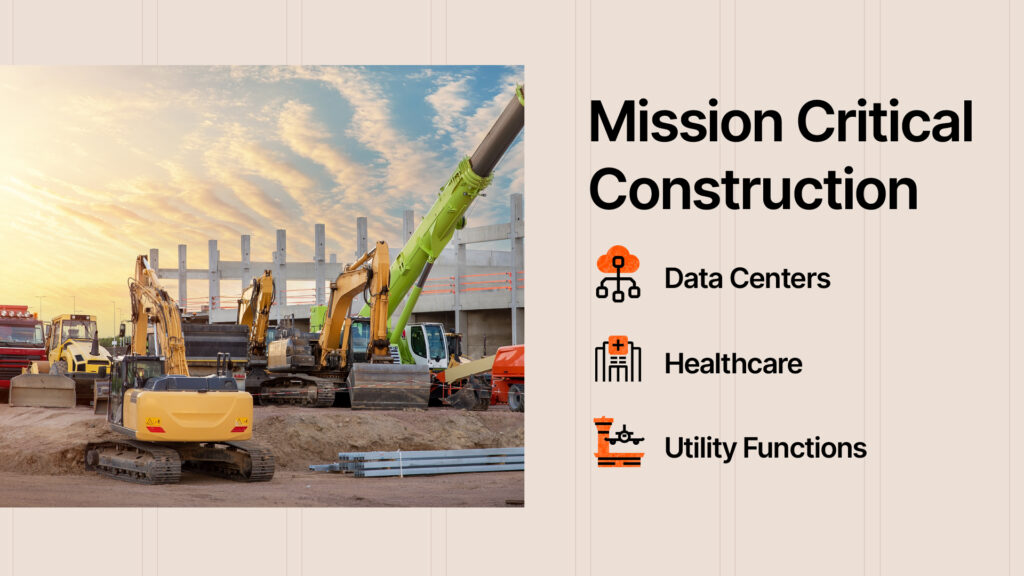— 6 min read
Building Healthcare Facilities: The Contractor’s Guide to Compliance
Last Updated Feb 4, 2025
Last Updated Feb 4, 2025

Navigating compliance when building hospitals, clinics and other healthcare facilities can be complex — because they’re often subject to more scrutiny from inspectors and other regulatory agencies.
Compliance involves the adherence to all regulations — local, state, federal and otherwise — as well as the necessary sign-offs from authorities having jurisdiction. It is one of the most critical areas when it comes to healthcare construction, as delays in this segment of a general contractor’s responsibilities can result in a project going off-course, out-of-budget, and beyond its timeline.
Even worse, a building’s failures in the area of compliance can result in devastating loss and illness inside of a hospital. Regulations must be followed for the safety of patients, healthcare staff and crew members alike.
This article explores how contractors can drive efficiency when it comes to navigating the challenges of healthcare construction, including how to form relationships with specialized regulatory bodies and best practices for working with the many stakeholders involved in a hospital or healthcare setting.
Table of contents
Navigating Regulatory Bodies
While all construction projects require permitting and inspections — the main elements of compliance — from a number of regulatory bodies, healthcare facilities often receive a high level of scrutiny from these bodies, given the purposes of the proposed buildings.
The project team will be tasked with compliance in the regular areas of any construction project such as HVAC, plumbing, electrical, and fire and life safety. However, due to the nature of these facilities, many of these disciplines need to be built to a higher standard.
In addition, a federal agency called the Centers for Medicare & Medicaid Services (CMS) enforces quality and safety standards for any facilities that receive funding from these two programs, and their own safety codes need to be followed.
Other administrations which offer regulation on the project specs include the Occupational Safety and Health Administration (OSHA), the Food and Drug Administration (FDA) — which regulates medical devices — and the Environmental Protection Agency (EPA).
Like other types of projects, healthcare facilities are subject to zoning laws and other oversights from local and state administrations, including health departments.
What can make managing the compliance of a healthcare construction site complicated, however, is that in some states, an extra department exists for the development of healthcare facilities in particular. In California, for example, this role is taken on by the Office of Healthcare Access and Information (HCAI).
This office approves all construction plans, conducts its own site inspections and makes sure facilities are built to withstand hazards — meaning that they are an additional layer of oversight, which is beneficial for occupant safety, but may possibly delay a project team during the build.
Generally, with HCAI, you do not have immediate access to the key decisionmakers. Adding another stakeholder to a project that already has a lot of stakeholders can slow things down. Additionally, the decisionmakers are not onsite everyday, so guidance and approvals can often move slowly.
Grant Honetschlager
Strategic Product Consultant, Owners
Procore Technologies
Planning carefully when it comes to any regulatory body is necessary to reduce risk of losing valuable time. Contractors must schedule meticulously and keep in proper communication with both government bodies and their project managers (PMs) onsite to make sure that the meetings schedule aligns with the needs on the ground.
Best Practices for Healthcare Compliance
It can be complicated to maneuver the increased scrutiny and additional regulatory bodies of healthcare construction, but following a few practices can push a project more smoothly through all inspections and into the handover phase.
Build relationships.
Teamwork is one of the most important aspects of a successful build, but opportunities for collaboration extend well beyond the project team — and it can be incredibly useful to build relationships with inspectors and contacts at AHJs, including authorities like HCAI.
Designs almost always need some kind of revision, so it’s important to understand that any design changes will require re-evaluation by regulatory bodies. Getting involved in the design process early and maintaining good relationships with regulatory bodies throughout the build can help mitigate the risk of losing time due to unforeseen circumstances.
Regulatory authorities often have a long backlog of reviews and approvals across the entire region they oversee. This means it could be a month or two before an important design change is approved — and if the construction schedule doesn't perfectly coincide with when that point of contact is going to show up and look at something, or even worse, they do show up and look at something, but reject it — it can cost weeks in the schedule.
Prioritize inspections.
Effective compliance management goes beyond technical expertise; it requires soft skills such as empathy, communication and respect.
It may sound simple, but making sure to treat inspectors with respect for their time and energy is an important part of building relationships — and failing to treat them this way can harm the trust that can carry into future projects — especially since many project teams who work in healthcare tend to repeat projects with the same inspection teams.
You never want to close up a wall and have the inspector feel like you just put drywall over something that they didn't get a chance to look at. They might not see it as an accident — they may think you’re covering something up. And then you have to tear down that wall and get them back to the jobsite. Building trust and a solid working relationship with your inspection team is critical to reducing friction on the project.
Grant Honetschlager
Strategic Product Consultant, Owners
Procore Technologies
Continuously review the master schedule.
Construction work tends to get off-schedule, especially when it involves the complex equipment and specialized needs of healthcare facilities.
A good way to re-align with the required timeline is to implement a three-week look-ahead schedule, in which the general contractor and project teams undergo regular reviews of the master schedule for the next few weeks and talk about potential issues proactively.
With the increased amount of inspections on some healthcare jobsites, using advanced scheduling software to check the needs of the timeline can help a GC stay afloat and not miss any important visits.
Collect and learn from data.
Data can be a powerful tool for project stakeholders, as many analytics tools can be useful to track any blockers with the project’s design, budget and make adjustments for future projects.
In a project as complex as a hospital, it’s important to collect good, clean data that can be used to learn lessons from each project. Some easy data points that can be analyzed can be found already in construction software.
For example, looking at change orders over a certain project can help a project team prepare for the kinds of mistakes and errors that may arrive in the next.
I haven’t had a report generated from change orders tracking what went wrong and what flaws were in the design, but I think that’s a miss for the industry overall. We could be walking away from every project with really cool insights about what’s commonly going wrong — and even bake that into pricing for the next bid.
Grant Honetschlager
Strategic Product Consultant, Owners
Procore Technologies
Courses about construction.
For construction.
Unlock your career potential with our free educational courses on Health & Safety, Data in Construction, and more.
Building a Reputation for Compliance
Navigating compliance in healthcare construction isn’t just about adhering to regulations; it's a strategic approach that can drive efficiency and secure future projects.
Building strong relationships with regulatory bodies and inspectors can help teams streamline the approval process and avoid costly delays. This is particularly important in the healthcare sector, where many project teams specialize and repeatedly work with the same inspection teams.
A reputation for reliability and compliance can lead to more opportunities and keep a construction company employed in the crucial and lifesaving work of building healthcare facilities.
A GC’s commitment to compliance — specifically in healthcare — demonstrates their values, safeguarding the future of both the industry and communities they serve.
Was this article helpful?
Thank you for your submission.
0%
0%
You voted that this article was . Was this a mistake? If so, change your vote here.
Scroll less, learn more about construction.
Subscribe to The Blueprint, Procore’s construction newsletter, to get content from industry experts delivered straight to your inbox.
By clicking this button, you agree to our Privacy Notice and Terms of Service.
Categories:
Tags:
Written by
Grant Honetschlager
Grant Honetschlager is a Strategic Product Consultant at Procore specializing in its Financial and Preconstruction tools. Prior to joining Procore, Grant managed healthcare and life science construction projects in Southern California. Grant is passionate about helping clients gather data and insights from their projects in order to make informed decisions on design, capital planning, and project delivery methods.
View profileTrey Strange
26 articles
Trey Strange is a Peabody and Emmy-Award winning writer and producer based in Brooklyn, NY. Throughout his career, Trey has worked for the Huffington Post, Houston Chronicle, Out Magazine, Brooklyn Eagle, CNBC, INTO, and New York Magazine's Bedford + Bowery. He received his Masters in Journalism and Middle East studies from New York University, and Bachelors in the same subjects from the University of Houston.
View profileExplore more helpful resources

Mission Critical Construction: Strategies for Success
Mission critical construction involves building structures whose functions cannot afford to fail, as any disruptions can lead to significant consequences for society. Keeping data centers, hospitals, power plants and other...

Modular Construction and MEP: A Collaborative Pairing
In an age of supply chain disruptions, workforce shortages, and rising material costs, off-site construction — including modular construction methods and prefabricated materials — is surfacing as a multipurpose solution....

Connected Construction: Transforming the Industry Through Integration
Construction projects are becoming increasingly complex, so companies need to innovate to accurately and profitably complete these modern structures. Connected construction — using technology and data to improve communication, processes...

Off-Site Construction: Prefab vs. Modular
As the construction world becomes ever more competitive, deadlines get tighter and the margin for error gets slimmer, project owners around the world are always looking for an edge. Thanks...